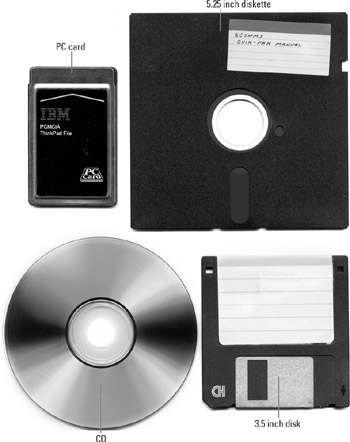Floppy Disks
Floppy disks, also known as diskettes, are a form of removable magnetic media that used to be the universal form of storage and distribution for personal computer programs and files. They are gradually disappearing from new computers because of their limited capacity. In today's computers, rewritable compact discs fill the niche that used to be occupied by floppy disks.
Diskettes are called floppy disks because the actual storage media inside the envelope or plastic case are flexible plastic disks covered with magnetic material. The first personal computers used 5.25-inch floppy disks that were enclosed in flexible envelopes. Through the 1990s, these were gradually replaced by 3.5-inch diskettes in rigid plastic cases. Figure 9.8 shows both types of floppy disk.

Figure 9.8: Larger 5.25-inch diskettes (top) have been rendered obsolete by 3.5-inch disks, which in turn are almost entirely replaced by rewritable CDs and other storage media.
Floppy disk drives use the same magnetic storage technology and track-and-sector structure as hard drives, but obviously, they're limited to the two surfaces of the disk. The HD letters on 3.5-inch diskettes stand for high density, which identifies the capacity of the disk as 1.44MB. Diskettes without the HD mark have a capacity of 720 kilobytes.
The maximum capacity of a 5.25 disk was 1.2 MB, but some older disks could only hold 360 kilobytes. Windows has inherited the practice of assigning letters to disk drives from the earlier DOS (Disk Operating System) operating systems. Because many early personal computers had space for two floppy disk drives, the letters A and B have always been reserved for floppy disk drives. Drive A: was assigned to the boot floppy (the floppy disk that contained the operating system) and C: to the first hard drive.
Floppy disk drives connect to the computer's motherboard through a dedicated 34-pin connector that can support one or two drives. Some older floppy drives use a card-edge connector rather than a multi-pin plug and socket, so the ribbon cable that connects the drive to the motherboard might have both types of connectors. Some newer floppy disk cables are round rather than flat, and they might not include the card-edge connectors.
Floppy Disk Drive (FDD) cables normally have a twist inside the cable between the first and second set of drive connectors. This twist changes the wiring connected to the seven pins that identify each drive as either the A: drive or the B: drive. Therefore, the A: drive must connect to one of the connectors near the end of the cable. In the unlikely event that your computer has a B: drive, it should use a connector on the other side of the twist (the twist may not be visible inside a round cable, but those cables usually have prominent labels on each connector).
Floppy disk drives are almost obsolete. Many new computers, especially laptops, come without a floppy disk drive, but the newest motherboard models still have an FDD connector, so it's still possible to add a drive if you need one. You can probably live without a floppy drive, unless you have some old floppies that contain your only copies of some important files or programs. If you need to add a floppy disk drive to your system, go ahead and install a new internal drive. Or as an alternative, consider using an external drive that connects through the USB interface rather than an internal drive. This allows you to share a single drive among more than one computer, and you don't have to mess with the internal drive bays and cables.
| Caution | Over time, floppy disks can accumulate dust and dirt, develop bad sectors, or fail completely. They are not a reliable long-term storage medium. If you have some old floppy disks that contain valuable files, you should copy them to a hard drive or a CD for long-term storage. |
| Tip | If you can't read a floppy disk, try rapping the edge of the disk on a table to loosen any dust or dirt. If that doesn't work, try another drive; the first one might be out of alignment or have dirty heads. If your drive frequently fails to read disks, pull the drive out and throw it away; you can buy a new internal floppy disk drive for less than $10. |
EAN: 2147483647
Pages: 372